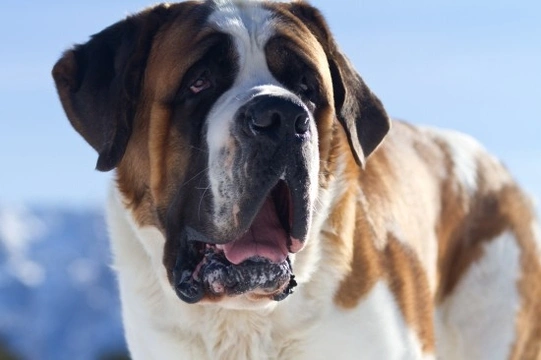
All about the St. Bernard dog
Anyone aged around 30 or older will no doubt remember “Schnorbitz,” the famous St. Bernard owned by British comedian Bernie Walters. Schnorbitz was responsible for raising the profile of the St. Bernard dog within the UK, and leading to a large increase in demand for dogs of the breed as pets during the 1980’s, with St. Bernards finding homes in a wide variety of houses as a result!
The St. Bernard is a giant dog breed hailing from the Swiss and Italian Alps, which was historically used to assist with mountain rescue and searching and assisting people who had been unlucky enough to be caught in avalanches. The traditional image of the St. Bernard depicts them holding a flask around their necks, containing an invigorating alcoholic spirit to help to revive people that they rescued from out of the snow!
Today, the St. Bernard has dropped in popularity within the UK somewhat as progressively more large and giant mountain-type dog breeds compete for homes among dog lovers who wish to own a giant dog breed. However, the St. Bernard is still a popular pet and companion dog in the UK, and is definitely worth consideration for those seeking to own a very large canine companion!
St. Bernard history
The St. Bernard is a molosser dog type that is thought to have been introduced to the Swiss Alps by the ancient Romans, and quickly segued into a wide rage of versatile working roles such as being used as cattle dogs, general farm dogs, livestock guardians, search and rescue dogs and watchdogs.
The St. Bernard has a long, well publicised and distinguished history as a mountain search and rescue dog first and foremost, and they were thought to have initially been bred in large numbers by monks from the monastery at the St. Bernard Pass, which gave the breed its name. Interestingly, the monks are renowned to never have trained the search and rescue dogs under their care, with young St. Bernards learning their trade from following the older dogs going about their duties!
The appearance of the St. Bernard dog
The St. Bernard dog is classed as a giant breed, weighing in at between 140 and 264lb, and standing up to 90cm tall at the withers. Their coat is generally mahogany or red mixed with white, and they have thick, heavy coats that can be either rough or flat. The St. Bernard’s eyes are very distinctive, appearing droopy and low hanging, giving the dogs something of a world-weary appearance!
Temperament
St. Bernards are gentle giants, and it is usually unanimously accepted that their impressive bark is much worse than their bite! St. Bernards make brilliant family dogs, and generally love their younger charges without ever being pushy or dominant; however, due to their large size, they do run the risk of knocking over smaller children when moving around! They are very laid back and tolerant of children as a general rule, even the occasional child who decides to have a go at riding on their backs, something that should of course be strongly discouraged!
St. Bernards need to be adequately socialised with other dogs to ensure that they are able to get along with strangers, and learn the limits of acceptable play with dogs that may be significantly smaller or lighter than them. Many smaller dogs will be intimidated by the large build of the St. Bernard and automatically yield dominance to the larger dog, so the St. Bernard must be trained to have good manners and not be overly pushy with more submissive dogs.
Incorrectly trained, the strength and size of the St. Bernard can prove too much to handle for even the strongest adult, so it is vital to ensure that the St. Bernard is well trained and taught to respect humans and training commands from a young age.
Health
Like all giant dog breeds, the St. Bernard has slightly elevated risk factors for a range of conditions that accompany their great size. St. Bernards are particularly fast growing even for a large dog breed, which can lead to incorrect bone development and fast bone degeneration if the dogs are not fed a highly nutritious and complete diet from the outset.
St. Bernards can be susceptible to eye problems including entropion or ectropion, caused by the eyelids turning either too far inwards or too far outwards respectively.
They also carry genetically inherited elevated risk factors for hip dysplasia, elbow dysplasia and osteosarcoma, a cancer of the bone. They are slightly more prone than most breeds to developing eczema, epilepsy and heart disease.
Taken as a complete picture, you could be forgiven for thinking that the St. Bernard’s fairly wide range of potentially inherited health defects makes them rather a sickly dog over all, but when compared to other giant breeds, they are not considered to be particularly any the less healthy than their large peers. The average lifespan of the St. Bernard dog is 8-10 years, with around one in five dogs living past 10 and the oldest recorded St. Bernard in the UK living to almost 13.



